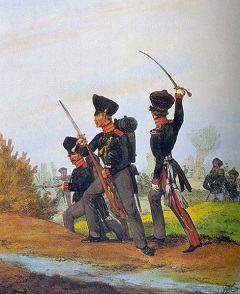On the March to Brandywine: — Part 1 of 10
Moving On Up
Thursday 4 a.m.
Cold plumes of smoke billowed from the chilled nostrils of the freshly awakened, gaunt British horses. They were being saddled by a group of Jagers who, under the command of Lord Cornwallis, would be in the vanguard of a column setting out from Head of Elk and marching toward Elkton.
British Captain Montresor reported that as the vanguard moved out they left behind two burning houses. It "appeared to have been done on purpose," he wrote.
The troops marched in formations wider than the road. The vanguard troops tore down fences and obstructions for those behind. The army on the march was impressive. A contemporary diarist noted that it was:
a beautiful sight to see ... as they came in sight on the river slope west of the town, with their scarlet coats, their bright guns and bayonets gleaming in the rays of an early August sun.
The day grew warm and clear as the column advanced. They progressed at the somewhat slow rate of about a mile and a half an hour, due in part to a massive cannon being hauled over rain-rutted roads.
After the five-hour journey, covering eight miles, the head of the column entered Elkton, by now a virtual ghost town, deserted in anticipation of the British arrival.
In fact, the crafty Delaware militia had taken supplies just minutes earlier and then scattered at the sight of the invaders, burning a bridge on the east end of town as they went. This inconvenienced the British slightly, forcing the invading column to ford a shallow creek before entering town. The Delaware militia retreated toward the elevations of Grey's Hill and Iron Hill, slightly to the northeast.
Howe arrived in Elkton by day's end and set up his headquarters at the Elk Tavern.
British and Hessian officers were quartered in houses deserted by residents. The 71st Regiment maintained the line of communication between Cornwallis's Division at Elkton and Knyphausen's predominantly Hessian Division which was still unloading from the ships.




